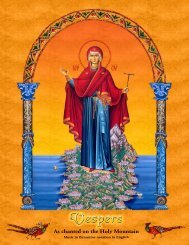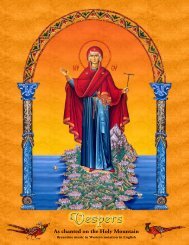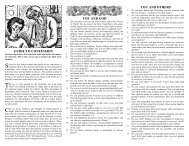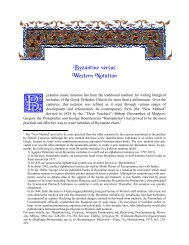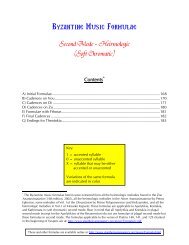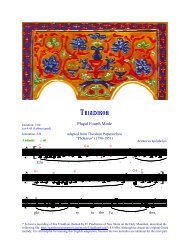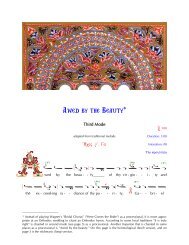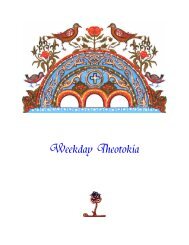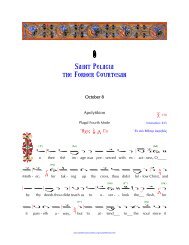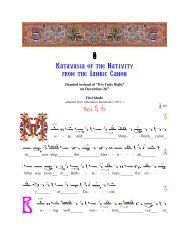Reading Psalmodia (PDF) - St. Anthony's Monastery
Reading Psalmodia (PDF) - St. Anthony's Monastery
Reading Psalmodia (PDF) - St. Anthony's Monastery
You also want an ePaper? Increase the reach of your titles
YUMPU automatically turns print PDFs into web optimized ePapers that Google loves.
The Pause z. indicates a silence of one beat's duration. Additional dots can be addedto a Pause, each dot adding a single beat to the duration of the pause.N.B. the Pause lasts the same number of beats as the number of dots its sign carries: aPause sign with two dots lasts two beats, not three.The pause can be affected by an argon or gorgon on the note following it orpreceding it. In such a case, the argon or gorgon affects the Pause in the same way itwould affect a sung note.A gorgon can also sit on a Pause - in order for this to happen, the Pause is writtenwith a dot, and the gorgon is written above the dot: in this case the Pause becomes aPause of 1/2 of a beat.6. QUALIFYING SIGNS:An important group of signs indicates specific modifications to the notes which areto be sung. There are five such signs normally used in church music.a] The Bareia or Heavy Accent; z This is, of course, the same sign that is used for apause. It gives a strong emphasis to the note which follows it, and makes it stand outfrom those preceding and following it. Unless the music is moving at a rapid tempo,the note following the Heavy Accent is sung with a slight grace-note sung a stephigher than the pitch indicated by the written note, to emphasize the drop into theaccented note. Sometimes the final half-beat of the note before the Heavy Accent israised a step, to the same effect.b] The Psiphiston or Accented Diminuendo; n This is written under an intervalsign that is followed by at least two more signs in a descending passage. Itaccentuates the note it sits under and operates on the whole group as a diminuendodoes. If, however, the note following it is accentuated because, for example, of itsmeaning, the Psiphiston merely accentuates the note it sits under.c] The Omalon or Ripple; v This sits beneath a sign and indicates the note is to besung with a gentle ripple of the voice; the actual figure sung varies from a slighttremor to a clear brief trill on the note above, to a kind of turn rising above andfalling below the note beneath which the Omalon is written.d] The Antikenoma or Shake; x This accentuates the note under which it iswritten and adds a more or less complex shake to it.e] The Eteron or Link; c This unites two notes so that they are sung on one breathwithout a break, but if they are on the same pitch with the flutter typical of a Petastiat the end of the first.13



